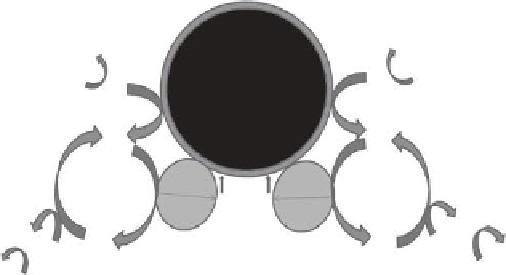Environmental Engineering Reference
In-Depth Information
Ni
0
Fe
0
NZVI
Ni
2+
Fe
2+
TiO
2
TiO
2
h
+
h
+
˙OH
Fe
3+
˙OH
Ni
3+
FIGURE 4.3
Enhanced photodechlorination eficiency of DCP and TCE by Fe/TiO
2
nanocomposites in the presence of Ni(II)
ions and 365 nm UV light under anoxic conditions. (Cited from Parshetti GK, Doong RA,
Water Res
, 45, 4198, 2011.)
4.5.3 Optimal Mass Loading
Several studies have depicted the effect of additive loadings toward the dechlorination
eficiency of chlorinated hydrocarbons by Fe
0
[81,82,94,95]. An optimal mass loading exists
for a wide variety of bimetallic catalysts. Tee et al. [82] investigated the role of bimetallic
Ni/Fe nanoparticles on the dechlorination of TCE. A higher degradation rate of TCE was
observed upon increasing the Ni loading from 2 to 25 wt%, and then the
k
obs
decreased
when greater Ni loading was added. Moreover, Lin et al. [55] reported that the dechlori-
nation rate of TCE by bimetallic Ru/Fe increased as the Ru loading increased from 0.25
to 1.5 wt%. A decrease in
k
obs
was also observed when Ru loading increased to 2.0 wt%.
In addition, Bransield et al. [95] depicted that a pronounced increase in
k
obs
with increas-
ing Cu loading was observed below 10 μmol Cu (g Fe)
−1
. Lee and Doong [57] reported
that an optimal mass loading of Ni at 1.47 wt% was also obtained for PCE dechlorina-
tion by zerovalent silicon. The possible explanation is that the addition of metal ions may
increase the numbers of nanocrystalline Ni particles on the surface of zerovalent silicon,
thus enhancing the catalytic activity for hydrodechlorination. The high loading of second
dopant metal, however, leads to the aggregation of ine catalytic nanoparticles into large
ones, and subsequently decreases the reaction rate of chlorinated hydrocarbons.
4.6 Reduction of Priority Pollutants by nZVI
4.6.1 Dechlorination of Chlorinated Compounds
The use of microscale and nanoscale ZVI for the reduction of organic contaminants has
been widely investigated. Microscale ZVI has been demonstrated to effectively dechlori-
nate many priority pollutants [14-16,72,96]. Matheson and Tratnyek [16] irst proposed three
possible pathways for dechlorination in the Fe
0
-H
2
O system. The irst pathway involves
the dechlorination of chlorinated hydrocarbons by electron transfer directly from the iron
surface to the adsorbed chlorinated hydrocarbons, which is believed to be the dominant


